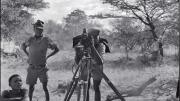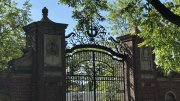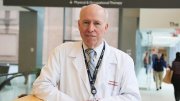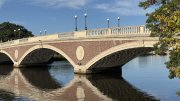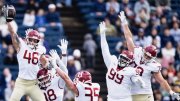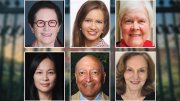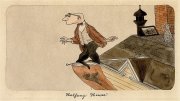At a dinner early in my freshman year, I received a piece of advice that has stuck with me ever after. Latanya Sweeney, professor of the practice of government and technology and the first black woman to earn a Ph.D. in computer science from MIT, convened a group of students of color at the Faculty Club to speak about our hopes, dreams, and fears about being at Harvard. The conversation quickly moved to the topic of excelling academically—and, just as quickly, to finding mentorship, or rather the difficulties of doing so for students of color.
When Sweeney was a student, she told us, mentors had to see themselves in you before they would take you under their wing. Most professors were white men, and still are. They were unlikely to see her brilliance. She decided on a different approach: asking questions of professors, receiving their answers, and then approaching others with similar questions. She went on this way, one by one, building her knowledge; eventually establishing a career of groundbreaking research, presidential advisory appointments, and stewardship of undergraduates as Currier House faculty dean.
That night, I played with my knife and fork, resting them at different angles on the pristine white plates upon which we were served, nervous about whether my food would be taken away if I kept them too close together. That nervousness dissipated over the years. But the only space in which it disappeared, even as professors and Harvard staff would bestow equally helpful advice on us, was one in which samosas, curry, and saag gosht—all dishes I grew up eating at home—accompanied their words.
I looked forward to each biweekly evening meeting of Harvard’s Mellon Mays Undergraduate Fellowship, a national program that provides financial and academic support for upperclassmen of color interested in pursuing humanities doctorates. After tiring and tumultuous days, Pam Gaddi, our unflappable coordinator, made sure we gained more than knowledge. These meetings continued for two years, first in person, then remotely through my pandemic senior year. Guests were invited to present on topics such as research methods, time management, and postgraduate pathways. These talks were designed to help us produce our senior theses, and to set good habits that would continue beyond college. In this way, the fellowship brought many mentoring insights, like those Sweeney found herself, directly to us.
We had enough to deal with staying whole amid the marginalizing pressures of a predominantly white institution, where the proportion of black professors is 3.5 percent, smaller even than the already paltry national average of 6 percent. We lamented for scholars of color denied tenured positions we believed they deserved, or who were limited, amid the shortage of tenure-track jobs, to short-term contracts that carry no possibility of tenure. Before and after meetings as these conversations played out in the news, our Mellon Mays cohort of 20 often spoke with each other about what we wished were different so the uphill fight to find and share our voices weren’t so steep.
These tensions between tradition and creation, preservation and change, felt like knotted threads inside me that required unraveling. There was a gulf between how people I knew, who’d been historically excluded from academic spaces, understood their own lives, and how universities, with their divisions among anthropology, art, and history, have tried to record those stories.
So, with the encouragement of advisers and the fellowship program, I declared a joint concentration in anthropology and history and literature, and soon after that, began a creative project that would wrestle with those boundaries. In a non-fiction production class, I made a final video examining the legacies of two Peabody Museum-affiliated ethnographers, Lorna and Laurence Marshall, who, throughout the 1950s, went on expeditions to the Kalahari Desert in Namibia. That short film grew into A New England Document, a senior thesis in which an artistry emerged that I could recognize as my own.
Growing up, I saw many films, but I never used to care about the images they showed. Then I saw Handsworth Songs in a film class taught by art, film, and visual studies (AFVS) lecturer Dennis Lim. For the first time, I saw onscreen what I felt inside when I read the news or watched it play out in the street. Fragmented, palimpsestic, and poetic, Handsworth Songs is a 1986 documentary investigating the anti-police uprisings that took place across England the year before. It was produced by the Black Audio Film Collective, a group of black British and diaspora artists in whose work a terrible beauty unfolds from imperial histories. Their films include moments that mix the unseen past with the visible present: in Handsworth Songs, the narrator describes how “a journalist is pestering a middle-aged black woman,” who “looks at him and calmly says, ‘There are no stories in the riots. Only the ghosts of other stories.’” I, too, wanted to show how people on the ground overturn dominant narratives without succumbing to their often-unfair standards.
So when I walked into a 2019 exhibition at the Peabody Museum of Archaeology and Ethnology featuring information about the Marshalls’ archive of 40,000 ethnographic photographs held there, I knew what I wanted to make: a film that would express how those they studied understood their encounter.
In researching the documentary, I found a photograph of an indigenous African perspective. It was captured by MIT scientist Robert Gesteland, who moonlighted as a photographer and was hired by the Marshalls for one of their expeditions sometime in 1957-58. In the image, titled “/Gaishay focusing the camera,” a young boy stares back (see photograph above).
The photo shows three Indigenous San Ju/’hoansi boys standing around a 16mm film moving-image camera, although the precise circumstances of how they interacted with Gesteland isn’t known. What’s clear is that one of the boys, /Gaishay, holds the technology his ethnographers used, even as the photograph itself stops us from seeing through his eyes; in that way, he remains a mystery, undefined. But even though /Gaishay’s cinema failed to materialize, mine did. His photographed pose—its stillness and concentration as he leaned into the camera— reminded me of my own posture as I turned ever so slightly to record street light upon the Charles River while making A New England Document. The film includes how /Gaishay might have seen the business of producing race; including excerpts from old advertisements and pictures of the Marshall family and the technology that they and the Ju/’hoansi used.
I started filming on the grounds where the Marshalls had walked in New England and where I now stood. Here, they owned two large family homes and earned money from Raytheon, the defense company that Laurence founded, to finance their expeditions. Working in this way also reminded me of how close I was to the people who sought to define him: the Marshalls’ children, Elizabeth Marshall Thomas ’54 (see harvardmag.com/e-marshall-19) and the late John Marshall, ’57, A.M. ’66 accompanied their parents on expeditions—an experience that influenced their own careers, hers as a writer and his as an ethnographic filmmaker. As Elizabeth drove me to Peterborough, New Hampshire, to film the family estate and record the film’s narration, she recounted witnessing the bloody footprint of Idi Amin’s rule during her travels through Uganda.
The words “New England” could describe all the territories of tribal peoples who continue to live on lands that the founders of Boston, Cambridge, and New Hampshire stole from them. Those same words could also describe how the British empire forever tethered itself to Trinidad, where I was born. When I was unsure of what to name the project, recognizing these diverse connections led me to A New England Document.
Carrying out the research with Mellon funding and an AFVS camera narrowed the distance between my position and /Gaishay’s as people who sought to say something through what we saw. After a semester working on the project, positive comments from my instructors increased my confidence in it. Then that fall, to my welcome surprise, scholar, filmmaker, and former Harvard College fellow in anthropology Veronika Kusumaryati emailed me late one night encouraging me to submit the work to film festivals. By then, the fellowship’s support enabled me to start buying books for research, and to travel to conferences and art exhibitions in New York and Paris, speaking to scholars and artists like Kusumaryati about what made them tick and why. One of these conversations brought my film to the attention of a leading international documentary festival in the UK; since then it’s had several screenings at conferences and other festivals.
These experiences were only a portion of how working on the project nourished me. Watching friends in the Mellon program present their theses at the year-end symposia, after we edited each other’s drafts and shared encouraging texts into the early hours, made me feel part of their achievements. Before that camaraderie, and the encouragement that came with it, I hadn’t considered the quality of creative talent—which remains unevenly recognized in American society—as something I should see in myself. Yet I now realize that in looking at art with a more focused eye beginning as a teenager, I was preparing to think artistically. As the fellowship progressed, the questions morphed from what I perceived to how I could create from those perceptions, challenging what I thought I knew.
One adviser on my project, Ernest Mitchell, was himself a Mellon Mays student as an undergraduate at Princeton. As we discussed the written thesis, which along with the film won a Hoopes Prize, he pushed me to stick with the photographs as a guide. Now an incoming assistant professor of English and humanities at Yale, he remarked that “it’s been deeply fulfilling to be able to mentor a new generation of Mellon Mays fellows” into “an ever-widening community of support and inspiration.” Indeed, in speaking about the film with Irène Vazquez, a recent Yale graduate, poet, and essayist, whom I met at the fellowship’s 2019 national conference, she saw things that led back to our mutual interest in Caribbean studies. A few weeks ago, we met again—this time for coffee in New York—and traded stories: where our college friendships had ended up and where our creative practices were going.
The photograph of /Gaishay and his kin has never before been published, but the conversations he started will continue. One remains central to me as an artist: why do we still seek to speak about others, and create hierarchies, as if we cannot speak with our participants and protagonists, and attend to what already exists for them? From the place he occupies in that picture emerges a world in which it is possible for black and indigenous people to imagine illimitable destinations, as Mellon Mays did for me and similar programs could do for so many others. Seeing him in the photograph, over and over again, with the project’s fellows and mentors, I took new turns and reached more understandings each time: in each other, we recognized a common future.
